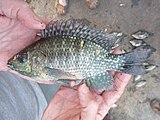| Polyacanthorhynchus | |
|---|---|
| Scientific classification | |
| Domain: | Eukaryota |
| Kingdom: | Animalia |
| Phylum: | Acanthocephala |
| Class: | Polyacanthocephala Amin, 1987 |
| Order: | Polyacanthorhynchida Golvan, 1956 |
| Family: | Polyacanthorhynchidae Golvan, 1956 |
| Genus: | Polyacanthorhynchus Travassos, 1920 |
Polyacanthorhynchidae is a family of parasitic worms from the phylum Acanthocephala. It contains a single genus Polyacanthorhynchus.
Taxonomy
Phylogenetic analysis has found that polyacanthocephala represents a distinct class of acanthocephalans.
Species
There are four species in the genus Polyacanthorhynchus.
- Polyacanthorhynchus caballeroi Diaz-ungria and Rodrigo, 1960
The complete genome of the mitochondria has been determined. P. caballeroi infect South American caimans.
- Polyacanthorhynchus echiyensis
- Polyacanthorhynchus kenyensis Schmidt and Canaris, 1967
P. kenyensis has been found infecting three freshwater teleosts: the Blue spotted tilapia (Oreochromis leucostictus), the Redbelly tilapia (Tilapia zillii), and the Largemouth bass (Micropterus salmoidein) in Lake Naivasha, Kenya. Samples were found in the liver of Tilapia and Orechromis and free in the body cavity in Micropterus It is the newest
- Polyacanthorhynchus macrorhynchus (Diesing, 1856)
P. macrorhynchus infect South American caimans.
- Polyacanthorhynchus nigerianus
- Polyacanthorhynchus rhopalorhynchus (Diesing, 1851)
Pirarucu collected in August 2004 from Araguaia River were found to have high prevalence values of P. rhopalorhynchus in their intestines. Cystacanths of P. rhopalorhynchus also have been found in the viscera of Hoplias malabaricus from Moca Vie River, Las Palquitas, Bolivia. Cystacanths were not deeply embedded in liver tissue but in a collagenous connective tissue capsule surrounded and attached to the liver surface. Necrosis of hepatocytes and subsequent inflammatory response were observed near encapsulated P. rhopalorhynchus. P. rhopalorhynchus infect South American caimans. Cyscanaths had: The number of proboscis hook rows was 16–18 posteriorly gradually decreasing in size. There are 8–10 circles of anterior cuticular trunk spines with about 34–40 minute spines each. Lemnisci not pronounced. Male cystacanths were 1.985–2.978 mm long by 397–662 wide significantly smaller than the size of adult males of 40–55 mm long. Females are larger with female cystacanths were 2.445–2.813 mm long by 430–496 wide significantly smaller than the size of adult males of 50–70 mm long. Male cystacanth proboscis (1.430–1.690 mm long by 169–208 wide) were smaller than female cystacanth proboscis (1.196–1.430 mm long by 169–208 wide). Male cystacanth proboscis receptacle (0.611–1.105 mm long by 130–195 wide) were also smaller than the female cystacanth proboscis receptacle (780–845 long by 156–195 wide).
Hosts
Polyacanthorhynchus species parasitize fish and caimans.
- Hosts for Polyacanthorhynchus species
-
 The Blue spotted tilapia is one of the hosts of P. kenyensis
The Blue spotted tilapia is one of the hosts of P. kenyensis
-
 The Redbelly tilapia is one of the hosts of P. kenyensis
The Redbelly tilapia is one of the hosts of P. kenyensis
-
 The Largemouth bass is one of the hosts of P. kenyensis
The Largemouth bass is one of the hosts of P. kenyensis
-
 Hoplias malabaricus is one of the hosts of P. rhopalorhynchus
Hoplias malabaricus is one of the hosts of P. rhopalorhynchus
Notes
- A binomial authority in parentheses indicates that the species was originally described in a genus other than the present genus.
References
- Garcıa-Varela, M., Cummings, M. P., de León, G. P. P., Gardner, S. L., & Laclette, J. P. (2002). Phylogenetic analysis based on 18S ribosomal RNA gene sequences supports the existence of class Polyacanthocephala (Acanthocephala). Molecular Phylogenetics and Evolution, 23(2), 288-292.
- "ITIS Standard Report Page: Polyacanthorhynchus". www.itis.gov. Retrieved 2020-08-20.
- "Polyacanthorhynchus caballeroi mitochondrion, complete genome". Zoologica Scripta. 2016-04-12 – via ncbi.nlm.nih.gov.
- ^ OMAR M. AMIN, RICHARD A. HECKMANN,S VICTOR INCHAUSTY, AND RENE VASQUEZ. Immature Polyacanthorhynchus rhopalorhynchus (Acanthocephala: Polyacanthorhynchidae) in Venton, Hoplias malabaricus (Pisces) from Moca Vie River, Bolivia, with Notes on its Apical Organ and Histopathology. J. Helminthol. Soc. Wash. 63(1), 1996, pp. 115–119
- ^ Echi, P. C., Suresh, K., Sanil, G., Iyaji, F. O., Nwani, C. D., & Ejere, V. C. (2015). Mitochondrial DNA resolution of two new sequences Polyacanthorhynchus echiyensis n. sp. and Polyacanthorhynchus nigerianus n. sp.(Polyacanthocephala: Acanthocephala) in a paratenic host from a tropical River. Environment Conservation Journal, 16(1&2), 13–17.url=https://environcj.in/wp-content/uploads/issues/2015/12/13-17.pdf
- Description of morphology available at: Amin, O. M., & Dezfuli, B. S. (1995). Taxonomic notes on Polyacanthorhynchus kenyensis (Acanthocephala: Polyacanthorhynchidae) from Lake Naivasha, Kenya. The Journal of parasitology, 76-79. Url=https://www.researchgate.net/profile/Omar_Amin/publication/15322210_Taxonomic_Notes_on_Polyacanthorhynchus_kenyensis_Acanthocephala_Polyacanthorhynchidae_from_Lake_Naivasha_Kenya/links/0046353b6ebbf25b21000000.pdf
- Dos Santos, Sonia; Ceccarelli, Paulo; Luque, Jose (July–September 2008). "Helminth parasites of pirarucu, Arapaima gigas (Schinz, 1822) (Osteoglossiformes: Arapaimidae) from Araguaia River, State of Mato Grosso, Brazil". 17 (3): 171–173.
{{cite journal}}: Cite journal requires|journal=(help)
| Taxon identifiers | |
|---|---|
| Polyacanthorhynchus | |